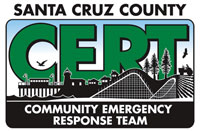Frequently Asked Questions about CERT
About the CERT Auxiliary of Santa Cruz County
What is CERT?
The Community Emergency Response Team (CERT) Program educates people about disaster preparedness for hazards that may impact their area (e.g. earthquakes or fires) and trains them in basic disaster response skills, such as fire safety, light search and rescue, team organization, and disaster medical operations.
Using the training learned in the classroom and during exercises, CERT members can assist others in their neighborhood or workplace following an event when professional responders are not immediately available to help. CERT members also are encouraged to support emergency response agencies by taking a more active role in emergency preparedness projects in their community.
Why take the CERT training?
Local government prepares for everyday emergencies. However, there can be an emergency or disaster that can overwhelm the community’s immediate response capability. Police, firefighters, and other first responders may not be able to help right away.
The primary reason for CERT training is to give people the decision-making, organizational, and practical skills to offer immediate assistance to family members, neighbors, and associates while waiting for help. While people will respond to others in need without the training, the goal of the CERT program is to help people do so effectively and efficiently without placing themselves in unnecessary danger.
Who can take the CERT training?
In addition to individual community members, other good fits are neighborhood watch groups, community organizations, communities of faith, school staff, workplace employees, scouting organization and other groups that come together regularly for a common purpose. CERT skills are useful in disaster and everyday life events.
Participants under 18 are welcome but require parental permission to attend CERT-related activities.
What’s in the training?
To become a CERT volunteer, one must complete the Basic CERT Classroom Training Course. The class consists of six modules with topics that include an Introduction to CERT, Fire Safety, Hazardous Material and Terrorist Incidents, Disaster Medical Operations and Search and Rescue. (More details)
The class is part lecture, part hands-on skills practice. Class time is typically 20 hours. Some classes are taught one evening a week. Other classes are run on weekends. Please check our calendar for upcoming trainings in Santa Cruz County.
What if I have concerns about my age or physical ability?
There are many jobs within CERT for someone who wants to be involved and help. Following a disaster, CERT members are needed for documentation, comforting others, logistics, etc. Non-disaster-related team activities may include keeping databases, developing a website, writing a newsletter, planning activities, helping with special events and organizing exercises and activities.
During CERT classroom training, if one has a concern about doing a skill like lifting, just let the instructor know. You can learn from watching. We would like everyone who wants to go through the training to have an opportunity to participate and learn the skills. CERT educates participants about local hazards and trains them in skills that are useful during disaster and life’s everyday emergencies.
How do I register for a training class?
See the calendar for upcoming trainings.
How can I maintain my CERT skills? (And re-certification)
CERT members and the local sponsoring agencies work together to maintain team skills. Please check our calendar for upcoming exercises and training opportunities in Santa Cruz County. See the Resources page for additional training and guidelines.
When you complete the Basic CERT Course, you receive a Disaster Service Worker (DSW) badge good for five (5) years. For re-certification, and to get an updated badge, here are the recertification guidelines and the steps to follow. Contact us if you need re-certification this year.
What can I do to help in an emergency if I haven’t taken the CERT training?
In the immediate aftermath of an earthquake, fire, explosion, or other disasters, it’s not uncommon for people to turn out in large numbers to assist victims, clear debris, and help on dozens of other tasks to get a community back on its feet.
This altruism is inspiring, but these unsolicited or “spontaneous” volunteers may be putting themselves and others at risk for injury and, in rare cases, death as a result of their lack of training in safe and proper disaster response. This can also delay or divert assistance from those already in urgent need of assistance.
Spontaneous volunteers also may not be familiar with the concepts of situation assessments, incident management, or chain of command. These three skills are essential in disaster situations, to ensure that resources get where they are needed as quickly as possible, rescues and relief efforts go to the most needed, efforts aren’t duplicated in one area while another area has absolutely nothing, etc.
CERT training can make you a much more knowledgeable and capable volunteer. If you haven’t taken CERT training, it may be best to accept guidance and direction from a trained volunteer.
How do I find a local CERT team?
See our list of local Santa Cruz County CERT teams.
How do you keep my personal information private?
See our Privacy Policy.
